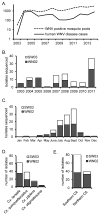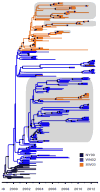Genotype-specific variation in West Nile virus dispersal in California
- PMID: 26210076
- PMCID: PMC4619151
- DOI: 10.1016/j.virol.2015.07.004
Genotype-specific variation in West Nile virus dispersal in California
Abstract
West Nile virus (WNV) is an arbovirus that was first reported in North America in New York in 1999 and, by 2003, had spread more than 4000 km to California. However, variation in viral genetics associated with spread is not well understood. Herein, we report sequences for more than 100 WNV isolates made from mosquito pools that were collected from 2003 to 2011 as part of routine surveillance by the California Mosquito-borne Virus Surveillance System. We performed phylogeographic analyses and demonstrated that 5 independent introductions of WNV (1 WN02 genotype strain and 4 SW03 genotype strains) occurred in California. The SW03 genotype of WNV was constrained to the southwestern U.S. and had a more rapid rate of spread. In addition, geographic constraint of WNV strains within a single region for up to 6 years suggest viral maintenance has been driven by resident, rather than migratory, birds and overwintering in mosquitoes.
Keywords: Arbovirus; Evolution; Phylogenetics; West Nile virus.
Copyright © 2015 The Authors. Published by Elsevier Inc. All rights reserved.
Figures





References
-
- Reisen WK, Fang Y, Martinez VM. Avian host and mosquito (Diptera: Culicidae) vector competence determine the efficiency of West Nile and St. Louis encephalitis virus transmission. Journal of medical entomology. 2005;42:367–375. - PubMed
-
- Apperson CS, Hassan HK, Harrison BA, Savage HM, Aspen SE, Farajollahi A, Crans W, Daniels TJ, Falco RC, Benedict M, Anderson M, McMillen L, Unnasch TR. Host feeding patterns of established and potential mosquito vectors of West Nile virus in the eastern United States. Vector borne and zoonotic diseases. 2004;4:71–82. - PMC - PubMed
-
- Turell MJ, O’Guinn M, Oliver J. Potential for New York mosquitoes to transmit West Nile virus. The American journal of tropical medicine and hygiene. 2000;62:413–414. - PubMed
Publication types
MeSH terms
Substances
Grants and funding
LinkOut - more resources
Full Text Sources
Other Literature Sources
Medical

